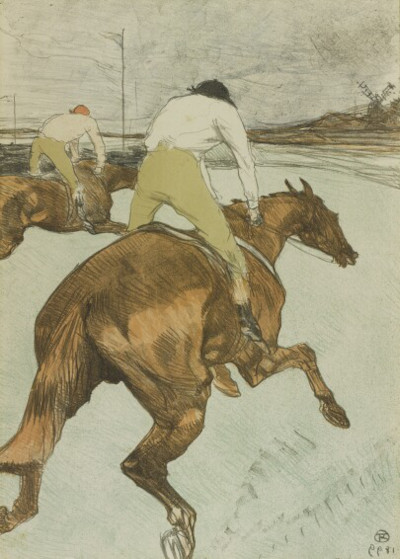This lithograph features two jockeys on horseback, striding across the landscape. One of the jockeys dominates most of this composition, though with some elements of the background visible in the distance.
The strong creature arrives from the bottom left corner as it hurtles along with a relatively small jockey clinging on to this powerful horse. Toulouse-Lautrec decides to fill the horse in with tones of brown, though the original detail shows through to provide contours around its body. Its frontend is reduced in size to help increase the feeling of perspective within this work. Its back, by comparison is powerful and covers much of this part of the paper. The horse's seat is left blank, and the rider just has some subtle tones in a creme colour across his bottoms. He leans over, attempting to achieve as stable a balance as possible in case the horse suddenly lurches from side to side without any warning. His colleague to the left hand side is just ahead of him, but its unclear as to whether they are racing each other at this time, or merely out enjoying a ride.
The landscape comes in from the right hand side, sweeping across the top of the painting. A windmill provides some scale and charm, whilst two flag poles to the left continue to structure the vertical balance of the work. The sky behind looks fairly sombre, but the artist could quickly all the entire mood of each lithograph by choosing a different tone for it. He adds some small marks to the ground to signify other horses to have passed this way previously, and then applies his standard stamp into the bottom right corner. Normally he would number any limited edition releases alongside the mark of authenticity, giving each print a uniqueness which might encourage buyers. Many of his posters were to advertise various businesses, but here we find no lettering and can treat this piece simply as a portrait of two jockeys.
The artist would produce many portraits of horses within his lifetime. Most would not be related to competitive horse riding such as this, though. He produced many portraits of horses in and around the family estate whilst a teenager and became very fond of these stunning creatures. He would also learn about horse riding from his father, though was never able to get involved himself because of his considerable physical shortcomings. His next best alternative was to paint them, and he sketched from afar within small sketchbooks in order to improve the manner in which he portrayed these animals. White Horse Gazelle is perhaps the most famous horse painting that he produced in his lifetime, though Jockey was also popular as a lithograph print.




